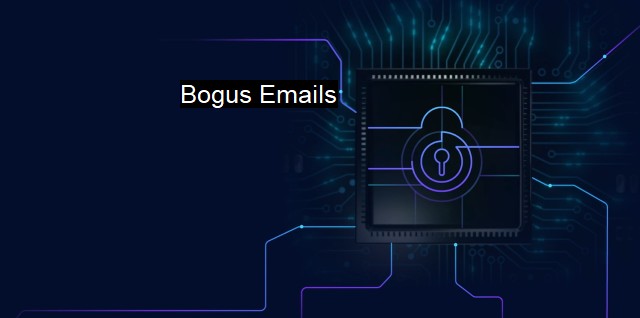What are Bogus Emails?
Rising Threats of Bogus Emails: How Cybercriminals Utilize Fraudulent Information to Endanger Cybersecurity
Bogus emails are fraudulent or deceptive emails, often sent with the intent to deceive or mislead the recipient in some manner. They present a serious challenge in the cybersecurity landscape due to their harmful intentions and the risk they pose to individuals and businesses alike. These emails are often crafted skillfully, making it difficult for a recipient to differentiate between a genuine email and a fake one.The world of cybersecurity often refers to these bogus emails as phishing emails. Phishing is a technique used by cybercriminals to entrap victims by falsifying emails to appear as though they've been sent from reputable sources. An email might look like it has been sent by a bank or a trusted institution, and victims are drawn into clicking on the links within the email. Once clicked, the link initiates the installation of malicious software, or malware, onto the victim's system or directs the victim to a mockup page where login details, credit card numbers, or personal information is requested and then exploited by the cybercriminal.
The relevance of antivirus protection in this context cannot be overstated. Although antivirus software may seem irrelevant to email phishing threats, they play a vital role in safeguarding systems from the potentially destructive effects of bogus emails. Effective antivirus software can detect and neutralize malicious attachments or scripts hidden within the bogus emails. Therefore, while an unsuspecting individual might inadvertently click on such a link, the malicious code won't execute if an antivirus system is active, thereby avoiding the associated harm.
It's worth mentioning that bogus emails are an example of social engineering, a tactic where psychological manipulation is used to trick users into making security mistakes or providing sensitive information. This differs from those attacks conducted through more direct means, such as brute-force attacks or malware infections, as it requires the voluntary action of the victim. Accordingly, antivirus software alone isn't always sufficient to detect and prevent such attacks.
To mitigate the threat posed by bogus emails, individuals and businesses must employ a multi-pronged approach. While antivirus software and firewalls form the basis of defending against standard malware and cyber threats, awareness training and good internet behavior are essential in combatting the risks of these fraudulent emails. Comprehensive cybersecurity practices include the ability to identify and report suspected phishing attempts, maintaining secure and unique passwords, regularly updating software, and being cautious when opening emails from unknown sources or that have unusual requests.
While technology continues to evolve, so too does the complexity and sophistication of bogus emails. Each deceptive email brings with it a new level of nuance design aimed at sidestepping strict cyberspace security measures. There is a concerning rise in the frequency of these cyberattacks, underscored by an increasing dependence on digital mediums for both professional and personal communication. As we move forward in the digital age, bogus emails continue to be a significant cybersecurity concern.
Bogus emails represent a form of cyberattack that leverages the art of deception to install malware or steal sensitive information. They bear a significant threat to cybersecurity due to the difficulty in distinguishing them from genuine emails. Antivirus software plays a fundamental role in mitigating the risk of bogus emails by detecting and neutralizing potential threats. they cannot entirely prevent such incidents. Therefore, consistent awareness training, information sharing, and regular system updates constitute essential practices in battling the rising tide of bogus emails. It is a collective endeavor of organizations, individuals, and security networks to effectively manage the ever-evolving challenge that bogus emails present in the realm of cybersecurity.

Bogus Emails FAQs
What is a bogus email?
A bogus email is a fraudulent email message that appears to be from a legitimate source, but is actually designed to trick the recipient into revealing sensitive information or installing malware on their computer.How can I identify a bogus email?
Bogus emails often have suspicious sender addresses, generic greetings, urgent requests, spelling and grammar errors, and ask for personal information or money. Always be cautious when opening emails from unknown sources and verify the sender's identity before responding.What should I do if I receive a bogus email?
If you receive a bogus email, do not reply to the sender, click on any links, or download any attachments. Report the email to your IT support team or the appropriate authorities and delete it from your inbox immediately.How can I protect myself from bogus emails?
You can protect yourself from bogus emails by keeping your antivirus software up to date, avoiding suspicious attachments and links, using two-factor authentication for online accounts, and educating yourself on cybersecurity best practices. Stay vigilant and always err on the side of caution when it comes to online communication.| | A | | | B | | | C | | | D | | | E | | | F | | | G | | | H | | | I | | | J | | | K | | | L | | | M | |
| | N | | | O | | | P | | | Q | | | R | | | S | | | T | | | U | | | V | | | W | | | X | | | Y | | | Z | |
| | 1 | | | 2 | | | 3 | | | 4 | | | 7 | | | 8 | | |||||||